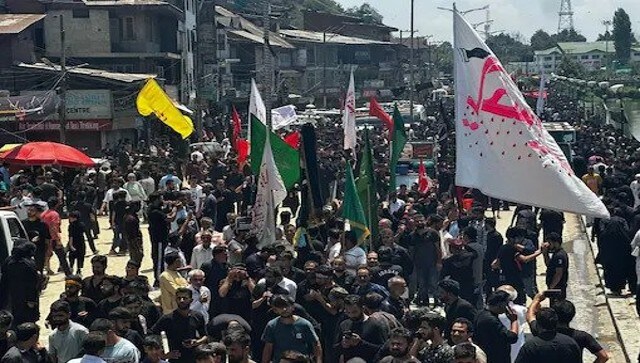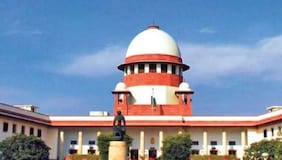How the abrogation of Article 370 has brought a new era of peace, progress and prosperity
The Muharram procession, which was held after a 34-year time hiatus, is being considered a pivotal historical shift in the Valley. This is just one of several changes taking place in the Valley post-2019

J&K Administration allowed Muharram procession in Srinagar after three decades. Image courtesy: News 18
Recent observations highlight the expanding development occurring in Jammu and Kashmir. This is evident, in particular, in an updated affidavit the Centre filed with the Supreme Court on July 10, which asserts that Jammu and Kashmir is experiencing an “unprecedented era of peace, progress, and prosperity” as a result of the abrogation of Article 370 in 2019.
The Centre has predicted that there will likely be no organised stone-pelting events connected to the terrorism-separatist agenda in 2023, down from 1,767 in 2018. Bandhs and hartals have also faded into obscurity. According to the Home Ministry, “resolute anti-terror actions” had destroyed the “terror ecosystem,” which substantially decreased the number of people joining terrorist organisations from 199 in 2018 to 12 as of today. The Home Ministry has the certainty to assert that street violence, which was encouraged by terrorist and separatist networks, has significantly decreased.
The government has also put in place a variety of schemes to help non-militant youth wean themselves off it. In reality, the government has practised its right to use the efforts for regional development as a result of the scrapping of Article 370. This is demonstrated by the completion of large-scale projects, the advancement of current initiatives, and the execution of centrally supported programmes, which have proved to be beneficial for the people (as claimed). These programmes are carried out by the district administration as well as various departments for the effective implementation of government schemes on the ground for eg; the recent smart city project in Srinagar. The government also ensured that the prevalence of mobile networks and banking connectivity reaches every village. Moreover, the region is viewed with exponential potential for tourism which is considered to be a pathway to restore normalcy and a steady push towards development.
Related Articles
According to the Centre, the abrogation of Article 370 gave Jammu and Kashmir’s women equal rights. The 70-year-old anti-women statute, known as Article 370, was in effect in Jammu and Kashmir, though there were some amendments which were made beforehand. Its repeal has sparked a profound shift in politics and society in the area, with women emerging as the face of the new order. Before August 2019, J&K’s women were prohibited from purchasing real estate in the state if they married a man outside the state. This restriction restricted women’s rights and their ability to choose a life partner. However, the Central government has granted the husband domicile status, allowing women to purchase property and submit employment applications. Moreover, the right to property is a powerful pathway in ensuring the elevation of power and status of women of Kashmir.
Another aspect which needed due attention is the dynamic in the Valley between the Shia and Sunni Muslims, which is the most intriguing aspect of Kashmiri society.
To further trace the positive impact of the abrogation of Article 370, it is important to understand the history and status of the Shia community in J&K. Shi’ism in Kashmir has a turbulent history that dates back more than a thousand years. In the Budgam district, the percentage of Shias is roughly 40 percent. Shia Muslims make up around 20 to 25 percent of the total Muslim population in Kashmir, according to estimates. They primarily live in Kashmir’s north and centre. The resurgence of sectarian politics and the spectacular rise of anti-Shia groups in Pakistan in the middle of the 1980s added fuel to the community’s anxieties. After the armed uprising in Kashmir began in the late 1980s, the community’s concerns worsened as some militant groups, actively supported by the Pakistani government and perceived by the community to be influenced by anti-Shia hate propaganda that was shattering Pakistan’s dreams, took the lead.
Although they are relieved that Article 370 is no longer in effect, the Shias were anxious that their situation will not get any better. On the other side, the Sunnis worry that they’ve irrevocably lost control and that nothing will ever be the same again. This environment is stressed by a recent event that took place in the region which is being considered as a pivotal historical shift. The 8th Muharram mourning procession was held on the customary route from Shaheed Gunj to Dalgate, passing via Lal Chowk, after a 34-year time hiatus. Starting from the morning of July 27, 2023, the Muharram procession moved through Srinagar. More than 25,000 Kashmiri Shia Muslims took part in the cortege. The UT Administration, under the direction of Lt Governor Manoj Sinha, made it possible for the procession to proceed successfully. The original Gurubazar commission and leaders of the Shia community shared several rounds of accommodations with the authorities. The customary path through Srinagar megacity was blocked for the Muharram procession more than 30 times by the ancient siyasat of Kashmir. The procession’s blessing is noteworthy because it was preliminarily interdicted for more than three decades. After all, the government believed that actors were sympathising with the secessionist movement. When J&K first saw bellicosity in 1990, it was outlawed.
Shias and security forces have disaccorded for the past three decades over the prohibition on gumming processions on the eighth of Muharram, the Islamic month when the community remembers and laments the casualties of the Battle of Karbala. Deputy Director General of Police in Srinagar, Vijay Kumar presided over a concerted meeting of the police and Central Armed Police Forces. According to a police spokesman, elderly officers talked about medications for Muharram, difficulties, security measures, and procession operation. The crowd has been covered via drones. Overall, the procession was well-planned and devoid of any of the former conflicts. Members of the Shia community including Shia leaders; Aga Syed Hassan Mosavi and Imran Raza Ansari took part in the procession, expressing their gratitude and joy for witnessing a scene that was unthinkable for them three decades ago.
Many cases that have passed to demonstrate the success of the repeal of Article 370 are discussed in this article. The goal is to keep moving forward in a way that guarantees J&K’s growth and integrity, free from any kind of outside hindrance or malign purpose.
The author is a research associate with Policy Perspectives Foundation and is pursuing PhD from Bennett University. Her areas of work include gender intersectionality, conflict and development. Views expressed in the above piece are personal and solely that of the author. They do not necessarily reflect Firstpost’s views.
Read all the Latest News, Trending News, Cricket News, Bollywood News,
India News and Entertainment News here. Follow us on Facebook, Twitter and Instagram.
also read

'Biggest change for the youth': Union Minister Jitendra Singh on 4 years of Article 370 abrogation
The Centre on this day in 2019 had revoked Article 370, which gave special status to the erstwhile state of Jammu and Kashmir, and bifurcated it into union territories of Jammu and Kashmir and Ladakh

Off-centre | Article 370 dead or alive: Supreme Court to decide
A Constitution Bench comprising CJI DY Chandrachud and Justices Sanjay Kishan Kaul, Sanjiv Khanna, BR Gavai and Surya Kant will decide its fate

Article 370 gone, Jammu and Kashmir shines with 3D vision of development, delimitation, domicile
J&K is slowly emerging out of its decades-old cycle of Islamist terrorism, intifada-style stone-pelting and halted growth. The Modi government’s vision is unfolding with 3Ds — development, delimitation and domicile


